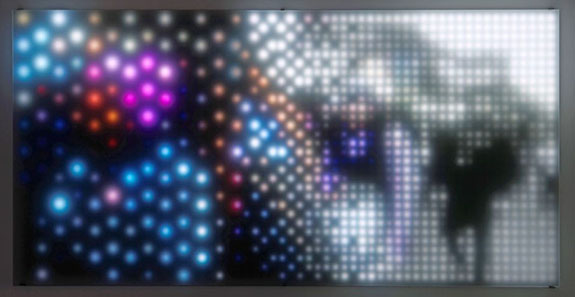
by Marcia Tanner
Jim Campbell’s ravishing if uneven solo exhibition of recent works reveals subtle yet significant shifts in his practice, both conceptual and technological. As is typical for him, the two are inextricably intertwined.
Over the past three decades, Campbell has used digital and electronic media, in increasingly ingenious and innovative ways, to make art devoted to exploring human thought, perception and feeling. Central to his investigations is the question of how we process information to understand and create meaning from our experience. He persistently pursues the question of 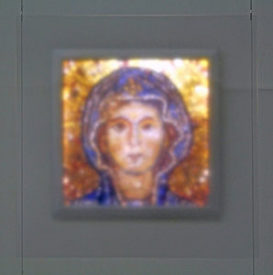
Campbell’s work challenges us to extrapolate from insufficient, overloaded or confusing visual cues, relying on memory and our innate capacity to recognize shape, color, motion and rhythm, in order to construct some measure of coherence from the chaos before us. Given the current state of things, these are no empty exercises. Many of the 15 elegant, exquisitely engineered new pieces in Far Away Up Close address perception as political activity — or rather, they present images of current political resistance that monopolize the field of vision but are persistently out of focus.
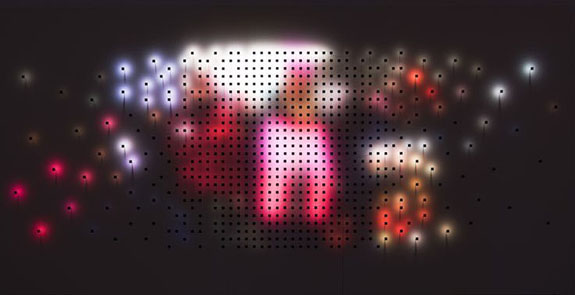
Some of the most arresting works derive from videos Campbell made at the 2017 Women’s March in Washington, DC. To capture video for the large-scale Splitting the Crowd, the centerpiece of the show and possibly his most cinematic work to date, Campbell faced an oncoming stream of marchers flowing around him and his camera. In typical Campbell fashion, Splitting dissolves the original high-definition digital images into an impressionistic low-resolution panorama that confronts the viewer with a colorful, and apparently unstoppable swarm of faceless human protesters. Seeing them as individuals requires that you distance yourself from the screen, but even that won’t bring the figures or the faces into focus. Standing closer only makes the imagery more foggy and abstract. Wherever you position yourself, clarity eludes you. Where are these marchers going? Will they reach their destination? These questions go unanswered.
What you do see up-close is a grid of 700 LEDs facing the metal screen, mounted on slender metal rods. Formerly, Campbell concealed the LEDs; they were aimed at the viewer behind translucent screens. He developed this new technique — it’s used on other pieces in the show, too — to reflect the imagery onto the piece’s opaque surface. This innovation softens the image and adds another layer of patterning and mediation to the works, while rendering them more obviously three-dimensional. (It’s also a prototype for the technology that will activate Day for Night, the monumental public art work Campbell is creating for the top six floors of the Salesforce Tower in San Francisco.)
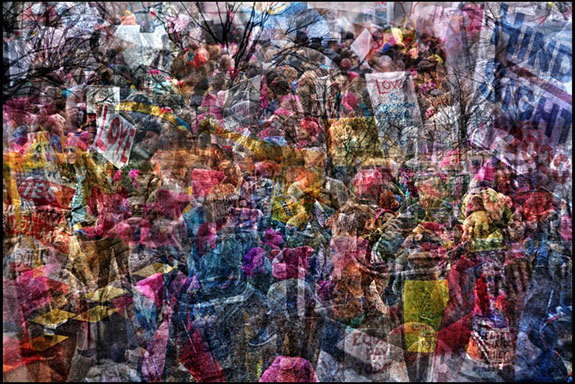
The LEDs are hidden in the vibrantly colorful Scattered 12x (Women’s March on Washington). Here, blurry moving images of a surging crowd distributed among a grid of twelve screens suggest how time and distance might dilute the details, yet paradoxically render more vivid memories of the actual event for its participants and spectators. The piece also provokes speculation about the long-term, real-life political impact of that momentarily unifying, now fragmented, mass demonstration of resistance.
In two lightbox works, Women’s March on Washington and Women’s March on Washington 3, the visual arena is dense with compacted overlays of high-resolution video stills, providing too much information. You can distinguish random individual faces and political signs amidst the hyper-Boschian confusion. But overall coherence is reduced, or maybe weirdly intensified, by the chaotic visual overload. Which is probably how it felt to be part of that event, and how it might feel to remember it.
Some of the most intriguing works are unrelated to the Women’s March. In Data Transformation 1, 2 and 3, made in New York City, Campbell presents videos of street traffic, human and vehicular. Each video is bifurcated: The right halves are higher-resolution, but have some visual information extracted; the left sides contain all of the data, but are so highly pixelated they are barely readable. In all three videos, both sides contain exactly the same amount of information, but they contradict each other, creating perceptual and cognitive dissonance as they vie for viewers’ attention. Which side is fake news?
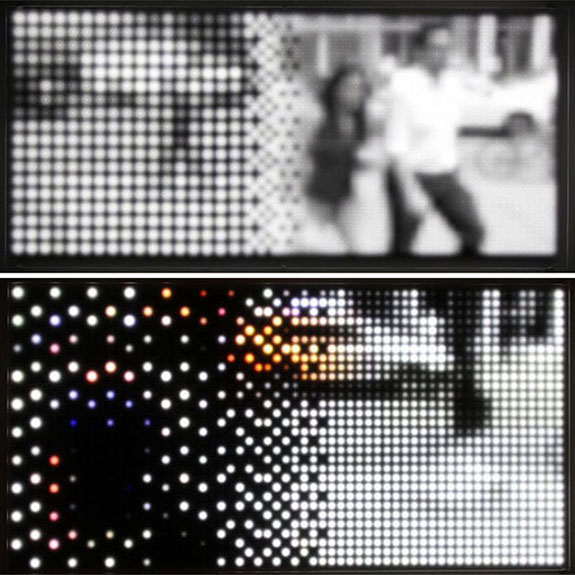
A group of "mosaic studies" reflects Campbell’s ongoing affinity for pixelation and the vagaries of focus. In this series, high-resolution color photo transparencies of portrait heads from Byzantine mosaics are set in light boxes, made blurry yet paradoxically more discernible by Plexiglas diffusion screens mounted a few inches away from the surface of the photographs. If you think of tesserae, the individual tiles used in mosaics, as proto-pixels — small cubes of stone, glass or ceramic from which recognizable imagery is composed — these ancient mosaics trouvés are appealing as Campbellian readymades. But like preliminary sketches from an artist’s notebook, the "studies" seem out of place in this show.
The most startling piece in the exhibition is Buried Thought. In stark contrast to Campbell’s low-resolution pieces based on human movement, this is a high-resolution color photograph of thick leaf litter on a forest floor, printed on Mylar. The image is totally obscured, though, by a pall of dull gray paint applied to the Plexiglas covering it. Behind the Mylar, an LED “spotlight” is 
Some of Campbell’s earlier works dealt soulfully with personal grief and loss. Buried Thought is in that vein. It will be interesting to see where he takes this next.
# # #
Jim Campbell: “Far Away Up Close” @ Hosfelt Gallery through October 14, 2017.
About the Author:
Marcia Tanner is a curator and writer who lives and works in Oakland. Exhibitions she has organized include Bad Girls West, Brides of Frankenstein, and We Interrupt Your Program. Her critical writing has appeared in ArtNews, Cabinet, the San Francisco Chronicle and many other publications. She is the author of numerous exhibition catalog essays.
excellent exhibition and review. thank you.
Thanks so much, Theodora! High praise, coming from you!
Marcia